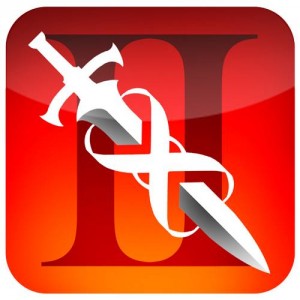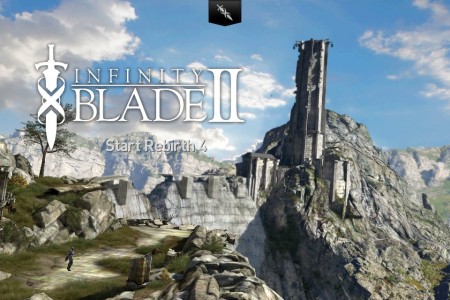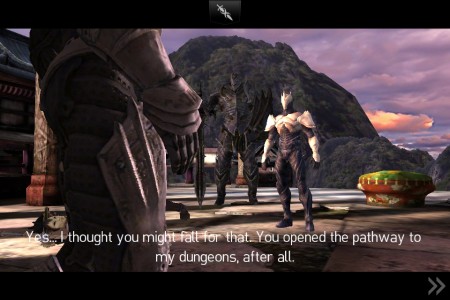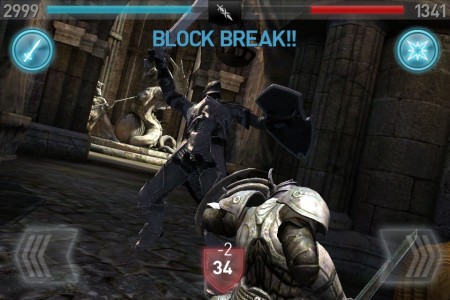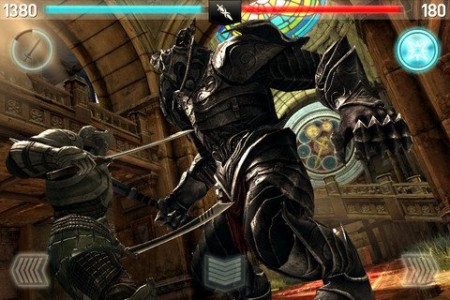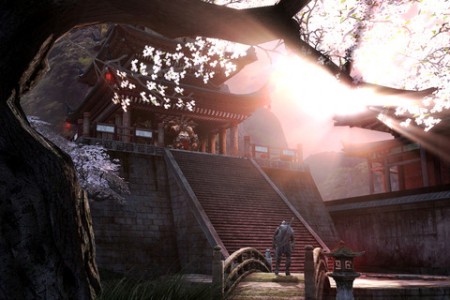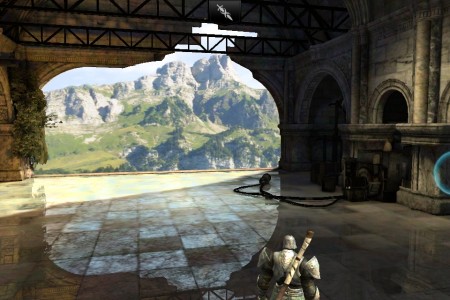Infinity Blade
Developer: ChAIR Entertainment
Publisher: Epic Games
Platforms: iPhone (reviewed), iPad, iPod Touch
Release Date: December 1, 2011
Price: $6.99 – (HERE)
Overview
We games journalists like to begin our reviews with a basic summary of a game and then pose a suspensful question as to whether the game is good or if it is not. It’s a simple method, peaks curiosity, and very often there’s the potential for some game-related puns. But to even question the design integrity of Infinity Blade II is to do it a disservice; the game is not only an instant iOS classic, it is also one of the best handheld games of all time.
Story
The original Infinity Blade‘s story could, at best, be called bare-bones, with only two major plot points, and both were infuriatingly cryptic. That problem has been resolved in the sequel.
Infinity Blade II is no Deus Ex, but its narrative is evolved in a more traditional and progressive manner, which helps infinitely in giving the player a bread-crumb trail of plot points until the game’s climactic ending. Twists abound, and several mysteries introduced by the first game are resolved, much to the contentment of my puzzled, on-the-point-of-an-aneurysm brain cells.
Siris, the developer-given name of the series’ hero (though you can change it to whatever floats your boat), is out to free humanity from the tyranny of the Deathless, and to do so he must find the Worker of Secrets and give him the now fully-activated Infinity Blade. Now that its on-button has been pushed, the sword will permanently end the life of whomever it slays, including the immortal Deathless.
Trouble is, the God King manages to get the sword back just after Siris figures out where the Worker is locked up; and on top that, to free the Worker, he’s going to have to eliminate a hit list of Deathless guarding the seals to the prison’s entrance in a well-fortified tower.
Queue adventure.
While the ending is as sequel-inducing as that of the first, you’ll definitely feel like the game resolves more questions than it poses, and it’s rather clear where the series is headed from there.
Gameplay
Remember that tower I mentioned? The minion-guarded, Deathless-containing one?
Well, much like the first game, Infinity Blade II charges you to undertake several assaults on the fortress; assaults that span multiple deaths and rebirths. Where the sequel surpasses its predecessor, however, is in the actual design of the tower.
No more are you retreading the same corrdiors and rooms over and over despite the passage of decades. This tower crumbles and ages as you progress through Siris’s rebirths.
A sapling will grow into a tower-encircling monolithicic tree, the clock-hall disentegrates as years fly by, and new passages are constantly opening and appearing, offering new paths to loot and monsters. You’ll never have to retread your steps exactly as there’s always a new way to explore the fortress, and this ensures that the game feels anything but repetitve.
ChAIR could have left it at that, in terms of changes to the original’s formula, and Infinity Blade II would have been a satisfactory sequel, but they went above and beyond in building upon the solid combat foundation laid down in the first entry of the series. Fights still rely on players avoiding damage in the buildup to a “break”, in which they can deal damage unhindered for a few seconds, but they now have more options in how to dish out the damage.
Players can stick to the classic sword and shield as equipment, which allows them to block, dodge, and parry enemy attacks, while dealing a predictable amount of damage on each break. But there’s also two new ways to battle and slay the monsters of Infinity Blade II, and both feel different enough to shake things up.
First, Siris can dual-wield weapons. This takes away the ability to block attacks, but upon parrying and evading into succesful breaks, players can tear into enemies by quickly building up high damage multi-combos. The second new combat option is equipping two-handed weapons. Wielding one of these hefty things takes away the ability to dodge, and you’ll have to correctly predict the direction of incoming blows to block them. Though this opens you up to taking far more damage, you’ll deal out massive amounts of punishment on each break if you correctly follow the on-screen queues informing you of which direction to swipe.
Each of the three loadouts has its benefits, and it’s hard to go back to the sword and shield after the high damage output of the other options. However, if you’re looking for the safest bet, with the most ways in which to survive a fight, there’s nothing as reliable as the classic Infinity Blade equipment.
The end of each fight sees you granted some gold and experience, and as you develop your ideal play-style, you’ll hone in on whether you want to add a few extra attribute points to boost your health or increase your damage output, among other options. The gold is used to purchase bigger and better items.
Though the game’s loot system will occasionally roll you a powerful item (I got a two-handed mace valued at well above anything I could afford on my second rebirth), for the most part, you’ll rely on gold to upgrade your weapons and armour. This will appeal to anyone who was a loot-hunter in Diablo or Borderlands, as every fight, every bag of gold, brings you closer to that bigger and better item. I was actually disappointed when I completed the game without having fully maxed-out my character. Thankfully for those who end up like me, upon completion, there’s New Game +, where you keep all your items, experience, and gold to play through the game’s gauntlets of enemies all over again.
There’s also been a plethora of smaller tweaks: the hidden keys that open locked chests with valuable items inside, the new, much cleaner inventory system, many more hidden sacks of gold in each environment for the keen observer, enemy attack patterns that are far less predictable than in the original, and the gem system that lets you imbue your loot with powerful attack, defense, gold, and experience bonuses.
It’s quite clear that in designing Infinity Blade II, ChAIR set out to address the concerns that the original game was repetitive. With the multiple combat styles, an ever-increasing number of branching paths, and the large amount of hidden secrets and items to look out for, the game’s greatest flaw is not that it ever feels repetitive, but rather that its loot and experience gain systems don’t always tie into the pacing of the overall story progression.
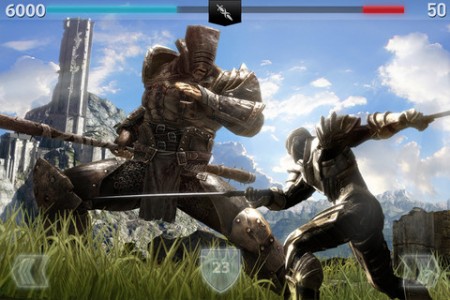
Audio & Visual
In case the screenshots haven’t tipped you off, playing through Infinity Blade II is a gorgeous experience. Everything from the lighting to the textures to the impressive vistas show that the game is getting the very most out of the Unreal engine, and there’s absolutely no other iOS game out there that can even come close to saying, “I look better.”
Very often, while scanning a location for bags of gold and hidden items, I found myself stopping and just enjoying the ambiance created by the game’s graphics. The best part is that Infinity Blade II‘s environments are far more varied than those of its predecessor. Whether it’s the Asian-themed opening location, dark crypts beneath the fortress, or an arena-like construct in which the aforementioned tree sprouts up from the ground, the game not only provides a feast for the eyes; it provides a feast that satisfies the wide variety of daily requirements from the food pyramid (that’s a metaphor everybody, the game doesn’t actually feed you).
And the sound design doesn’t hold any punches either. The dramatic clang of metal on metal, Siris’s slow footsteps on stone ground, and the haunting soundtrack that rises at just the right moments add to a stunning visual experience in a way that makes the world of Infinity Blade feel like a place that could exist, in a land far away.
That feeling is helped significantly by the designer’s decision to voice-act the game in English, rather than the subtitled language of the first game. Dramatic moments are much better punctuated when a character speaks with the nuances and hesitancies of a language you recognise, rather than the single-emotion mumbo-jumbo of the first game, and Infinity Blade II expertly plays out such moments.
My only issue with the game’s overall presentation is that the kill animations are all catered to the original’s sword and shield. That means that when I was dual wielding a two-handed warhammer, the final blow often resulted in Siris using the weapon one-handed and somehow shoving the blunt object through a monster’s stomach. While it always brought forth a chuckle, I’m fairly certain comedy wasn’t what the developers were going for.
Overall
Infinity Blade II is an outstanding game. It betters the original, which was great in its own right, in every conceivable manner and makes it look like B-grade amateur work.
The furthering of the combat mechanics, the depth of the game’s loot collecting systems, and the grand graphical spectacle all ensure that ChAIR’s latest effort will become a classic, renowned not only in this generation, but in those to come. It has a few pacing issues, and the odd animations occasionally take you out of the exerience, but Infinity Blade II is an experience that gets the best out of the iOS devices, through its smooth controls and wonderful presentation.
Do yourself a favour and buy this game.
Then together we can climb tall cliffs, look at distant castles, and darkly proclaim, “Worker, I will free you.”



